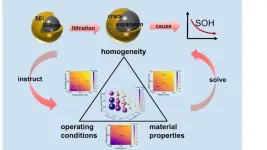(Press-News.org) Bottom Line: The risk of detecting cervical precancer eight years after a negative human papillomavirus (HPV) screening was found to be similar to the risk after three years (the commonly recommended screening interval) after a negative cytology screening.
Journal in Which the Study was Published: Cancer Epidemiology, Biomarkers & Prevention, a journal of the American Association for Cancer Research (AACR)
Authors: Anna Gottschlich, PhD, MPH, assistant professor at Wayne State School of Medicine and the Barbara Ann Karmanos Cancer Institute
Background: Over the past two decades, the United States has been transitioning from cytology to HPV-based screening for cervical cancer. The U.S. Preventive Services Task Force currently recommends one of three options for routine cervical cancer screening: 1) cytology screening every three years; 2) HPV screening every five years; or 3) co-testing in which both an HPV and cytology screening are conducted every five years.
“There is currently a global shift from conventional cervical cancer screening methods like cytology, or the Pap smear, to HPV-based screening because HPV-based screening has a higher sensitivity to detect precancerous lesions,” Gottschlich said. “However, some have expressed concern that the longer interval between HPV screens may increase the risk for the development of cervical cancer. These findings should provide assurance that the five-year interval recommended for HPV screening is even safer than the three-year interval for cytology screening.”
Due to available high-performance screening methods, such as the HPV test, and the HPV vaccine, cervical cancer is highly preventable, which is why the World Health Organization (WHO) has called for the global elimination of cervical cancer by 2030; defined as reducing new cases to four or fewer per 100,000 annually. Even though many high-income countries have established cytology-based screening programs, which have led to decreased incidence rates, many still have rates above the WHO’s elimination threshold goal, including in the United States where incidence is 7.6 per 100,000 individuals, according to federal statistics.
How the Study was Conducted: As more countries adopt HPV screening programs to accelerate the elimination of cervical cancer, Gottschlich said questions remain about the optimal interval between screens, which is why she and her colleagues designed a study to investigate the long-term risk of cervical precancer after negative HPV screening compared to after negative cytology screening, the latter of which has been used to guide previous screening recommendations. In this longitudinal study, they examined data from four cohorts of women and individuals with a cervix:
5,546 who had one negative HPV screen;
6,624 who had two consecutive negative HPV screens four years apart;
782,297 who had one negative cytology screen; and
673,778 who had two consecutive negative cytology screens two to three years apart.
Gottschlich and colleagues used data from the Canadian HPV For Cervical Cancer Prevention (HPV FOCAL) randomized trial conducted between January 2008 through December 2016 and its 14-year longitudinal follow-up FOCAL-DECADE study for the HPV screening cohorts. Data were used from the British Columbia Cervix Screening Program during the same interval for the cytology cohorts. Participants from each cohort were between the ages of 25 and 65 at the initial screen.
Results: Cumulative risk of cervical intraepithelial neoplasia grades 2 (CIN2), 3 (CIN3), and higher (referred to as CIN2+ or CIN3+)—which are premalignant lesions of cervical cancer—were calculated for each cohort. The risk of CIN2+ eight years after one (3.2/1,000) or two (2.7/1,000) negative HPV test(s) was similar to that of three years after one (3.3/1,000) or two (2.5/1,000) negative cytology screen(s). After six years, longer than current five-year guidelines, HPV screens showed lower risk after both one (2.5/1,000) and two (2.3/1,000) negative tests. Risk of CIN3+ was also lower or similar in the HPV cohorts following eight years compared to the cytology cohorts after three years.
While risk for CIN2+ was higher for HPV screening for intervals longer than eight years compared to cytology after three years, the detection of cervical precancer still remained low after negative HPV screening during the 14-year duration of the study period and was significantly lower than normal cytology screening over that period.
Author’s Comments: “HPV screening performs better than cytology by detecting more precancer earlier, which can then be treated earlier,” Gottschlich said. “We saw that in our study population, even those who had only one negative HPV test were at very low risk for the development of cervical precancer for many years after the negative test.”
Gottschlich said that these results could better inform updated screening guidelines for cervical cancer, but each country or province will need to determine the right guidelines given their populations and the resources at their disposal.
“Policy leaders need to consider a broad array of factors in health decision-making in their settings when considering how to prioritize HPV-based screening over cytology,” Gottschlich said. “Optimal implementation strategies depend on the kind of screening engagement and resources available in each specific program.” Gottschlich noted that it is also important to consider the potential loss to follow-up that comes with long screening intervals. “Extending intervals require health system considerations to ensure adequate continued engagement to minimize loss to follow up,” she said.
Longer intervals between testing, however, could allow for the realignment of resources to reach under-screened or unscreened populations and to encourage follow-up, Gottschlich added. “Screening alone is not sufficient to eliminate cervical cancer. We need to ensure that women who have an abnormal screen have access to diagnostic follow-up and treatment if necessary.”
Future studies will continue to follow these cohorts to better understand optimal implementation strategies for HPV screening, including appropriate ages for entry and exit into screening and triage management strategies.
Study Limitations: Limitations of this study include the fact that even though participants in the HPV FOCAL were randomly assigned at the start of the trial, differences in drop-out and screening rates may have made the HPV groups less comparable over the course of the study; however, loss to follow-up was low. Additionally, co-testing was used during exit screens, where two cases of CIN2+ were caught in cytology that were missed by the HPV test. Gottschlich said this did not affect the main findings as a previous study found that cytology missed over eight times more CIN2+ compared to HPV screening. Also, the study was conducted in a population that was very well screened, so the results are not directly applicable to low-resource settings.
Funding & Disclosures: The study was funded by the National Institutes of Health, the Canadian Institutes for Health Research, and the Michael Smith Foundation for Health Research.
Gottschlich reports receiving grant funding and travel support from Michael Smith Health Research BC.
END
HPV testing for cervical cancer may be safe at longer intervals than what current guidelines recommend
HPV testing eight years after a negative result instead of the recommended five was found comparable to standard cytology screening
2024-05-22
ELSE PRESS RELEASES FROM THIS DATE:
Investigating failure mechanisms of solid electrolyte interphase in silicon particles
2024-05-22
Lithium-ion batteries are widely used in new energy vehicles due to their low self-discharge rate and long cycle life. Currently, the anode material of commercial lithium-ion batteries mainly adopts graphite, with a theoretical capacity of only 372 mAh g-1 — which has gradually failed to meet the increasing demand for energy density.
Silicon has been widely studied by virtue of its high theoretical capacity of 4200 mAh g-1. However, silicon produces volume changes of up to 300% during lithiation and delithiation, and the ensuing mechanical degradation and capacity loss hinder applications. To reduce the adverse effects caused by mechanical deformation, silicon structure optimization ...
Legacy of Indigenous stewardship of camas dates back more than 3,500 years, OSU study finds
2024-05-22
An Oregon State University study found evidence that Indigenous groups in the Pacific Northwest were intentionally harvesting edible camas bulbs at optimal stages of the plant’s maturation as far back as 3,500 years ago.
The findings contribute to the growing body of research around Traditional Ecological Knowledge and practices, demonstrating the care and specificity with which Indigenous groups have been stewarding and cultivating natural resources for millennia.
Camas is an ecological and cultural keystone, meaning it is a species that many other organisms depend on and that features prominently within many cultural practices.
“If you think about salmon as being a charismatic ...
Regular fish oil supplement use might boost first time heart disease and stroke risk
2024-05-22
Regular use of fish oil supplements might increase, rather than lessen, the risk of first time heart disease and stroke among those in good cardiovascular health, but may slow progression of existing poor cardiovascular health and lower the risk of death, suggest the results of a large long term study, published in the open access journal BMJ Medicine.
Fish oil is a rich source of omega 3 fatty acids, and as such, is recommended as a dietary preventive to ward off the development of cardiovascular disease. But the evidence on how much protection it affords is inconclusive, explain the researchers.
To strengthen the evidence base, they set out to estimate the associations ...
Some teen girls clocking up close to 6 smartphone hours/day, Finnish study finds
2024-05-22
Some teenage girls are clocking up close to 6 hours a day on their smartphones, with a significant proportion of them likely addicted to social media, finds research published online in the journal Archives of Disease in Childhood.
Social media addiction was associated with poorer health and wellbeing, the findings indicate.
Recent research has linked increasing levels of anxiety among teen girls with social media use, note the researchers. This may involve several factors, one of which is addiction, with estimated international prevalence ranging from 5% to 31%, they add.
Because both anxiety and social media use are more common among girls, the researchers wanted to: measure ...
Pedestrians may be twice as likely to be hit by electric/hybrid cars as petrol/diesel ones
2024-05-22
Pedestrians may be twice as likely to be hit by an electric or hybrid car as those powered by petrol or diesel, finds a study of 2013-17 casualty rates in Great Britain, and published online in the Journal of Epidemiology & Community Health.
The risk is greater in urban areas, and governments must take steps to mitigate this safety hazard as they proceed to phase out fossil fuelled vehicles to improve air quality and curb climate change, urge the researchers.
Road traffic injuries are the leading cause of death for children and young people, and 1 in 4 road traffic deaths are of pedestrians, they note.
Amid ...
Scientists create tailored drug for aggressive breast cancer
2024-05-22
Scientists have used breast cancer cells’ weakness against themselves by linking a tumour-selective antibody with a cell-killing drug to destroy hard-to-treat tumours.
The research, published today in Clinical Cancer Research by a team from King’s College London and funded by Breast Cancer Now, marks a new method in cancer treatment.
The discovery is particular to triple negative breast cancer, which makes up 15% of all diagnosed breast cancer. This type of breast cancer is typically aggressive, resistant to chemotherapy, has a lower survival rate and is more common in women under 40.
Usual treatment involves surgery, chemotherapy ...
Language change harms our ability to communicate and understand
2024-05-22
EMBARGO: WEDNESDAY 22 MAY, 00:01 BST (TUESDAY 21 MAY, 19:01 ET).
Changes to the definitions of conceptual words like ‘woke’ and ‘gaslighting’ are harming our ability to communicate and understand our experiences, a Leeds academic argues.
In a new paper published in The Philosophical Quarterly journal, an ethicist at the University of Leeds has coined a term for the harm caused when language change leaves us lost for words.
Words such as ‘woke’, ‘depression’, ...
Jamestown Colony residents ate dogs with Indigenous ancestry
2024-05-22
Dogs with Indigenous ancestry were eaten during a period of starvation at Jamestown, the first English settlement in North America in the 17th century, according to new research in American Antiquity, published by Cambridge University Press on behalf of the Society for American Archaeology.
This discovery changes historians’ understanding of how Indigenous communities negotiated their relationship with rising colonial powers during this period. It also suggests that early European colonists depended on local Indigenous communities for their very survival, especially during the initial settlement period.
Researchers analysed ancient mitochondrial DNA from archaeological dogs from Jamestown ...
Australian study proves ‘humans are planet’s most frightening predator’
2024-05-22
Australia lacks fearsome large carnivores like lions and wolves, and the relative lack of fear that marsupials like kangaroos and wallabies show to dogs (and other introduced carnivores) has been attributed to a lack of evolutionary experience with large mammalian predators. This, however, overlooks the 50,000-year-long presence in Australia of the world’s most fearsome predator – the human ‘super predator.’
A new study conducted by Western University biology professor Liana Zanette, in collaboration with Calum ...
New York Valves 2024 late-breaking clinical trials and science announced
2024-05-22
NEW YORK – May 21, 2024 – The Cardiovascular Research Foundation® (CRF®) has announced New York Valves: The Structural Heart Summit will feature 12 Late-Breaking Clinical Trials and Science presentations. New York Valves 2024, the expanded iteration of our renowned annual Transcatheter Valve Therapy (TVT®) conference, will take place June 5-7, 2024, at the Jacob K. Javits Convention Center, North in New York City.
For nearly two decades, CRF® has led the way in pioneering transcatheter therapies for structural heart ...
LAST 30 PRESS RELEASES:
Air pollution exposure and birth weight
Obstructive sleep apnea risk and mental health conditions among older adults
How talking slows eye movements behind the wheel
The Ceramic Society of Japan’s Oxoate Ceramics Research Association launches new international book project
Heart-brain connection: international study reveals the role of the vagus nerve in keeping the heart young
Researchers identify Rb1 as a predictive biomarker for a new therapeutic strategy in some breast cancers
Survey reveals ethical gaps slowing AI adoption in pediatric surgery
Stimulant ADHD medications work differently than thought
AI overestimates how smart people are, according to HSE economists
HSE researchers create genome-wide map of quadruplexes
Scientists boost cell "powerhouses" to burn more calories
Automatic label checking: The missing step in making reliable medical AI
Low daily alcohol intake linked to 50% heightened mouth cancer risk in India
American Meteorological Society announces Rick Spinrad as 2026 President-Elect
Biomass-based carbon capture spotlighted in newly released global climate webinar recording
Illuminating invisible nano pollutants: advanced bioimaging tracks the full journey of emerging nanoscale contaminants in living systems
How does age affect recovery from spinal cord injury?
Novel AI tool offers prognosis for patients with head and neck cancer
Fathers’ microplastic exposure tied to their children’s metabolic problems
Research validates laboratory model for studying high-grade serous ovarian cancer
SIR 2026 delivers transformative breakthroughs in minimally invasive medicine to improve patient care
Stem Cell Reports most downloaded papers of 2025 highlight the breadth and impact of stem cell research
Oxford-led study estimates NHS spends around 3% of its primary and secondary care budget on the health impacts of heat and cold in England
A researcher’s long quest leads to a smart composite breakthrough
Urban wild bees act as “microbial sensors” of city health.
New study finds where you live affects recovery after a hip fracture
Forecasting the impact of fully automated vehicle adoption on US road traffic injuries
Alcohol-related hospitalizations from 2016 to 2022
Semaglutide and hospitalizations in patients with obesity and established cardiovascular disease
Researchers ‘listen in’ to embryo-mother interactions during implantation using a culture system replicating the womb lining
[Press-News.org] HPV testing for cervical cancer may be safe at longer intervals than what current guidelines recommendHPV testing eight years after a negative result instead of the recommended five was found comparable to standard cytology screening


